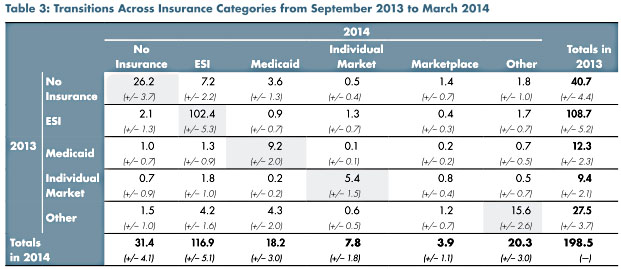Today brings yet another take on Obamacare from Rand’s latest survey of the health insurance market. Rand’s sample size is fairly small, so there are large error bars associated with their numbers, but they also break them down in interesting ways. The number we’ve been tracking most closely in the other surveys on insurance is the number of uninsured who got coverage via Medicaid or the exchanges, which Rand displays in the top row of this table:

About 5 million previously uninsured people got coverage via Medicaid and the exchanges. This is slightly lower than other estimates, but only slightly. When you account for the March surge and the sub-26ers on their parents policies, you’re probably back up to about 8 million. We’ll have a better idea about this next month, but so far this is roughly consistent with other surveys we’ve seen.
But there’s one stunning number in the Rand survey that we haven’t seen before: the dramatic surge in people who have employer insurance (ESI). According to Rand, 8.2 million new people—7.2 million of them previously uninsured—have gotten employer insurance since mid-2013. Adrianna McIntyre is agog:
I can’t overstate how stunning this finding is if it’s true; CBO expected that ESI gains and losses would pretty much break even in 2014 and that employer coverage would decline modestly in future years.
If it’s correct, it was probably motivated multiple factors—I hate the word “synergy” on principle, but it comes to mind. The economy has been improving, so some of the previously unemployed have secured jobs with benefits. But CBO built in expectations about economic recovery, so I don’t think it’s quite right to try pinning all (or even most?) of the 8.2 million on that. The individual mandate, while weak in its first year, might be a stronger stick than we expected, nudging people to take their health benefits where they’d previously been opting out. Employers could be helping this move this trend along; the University of Michigan, for example, eliminated “opt out dollars” in 2014 (cash compensation for employees who declined coverage).
If this finding is confirmed, it’s a genuine shocker. Although CBO projected that ESI would stay steady, there’s been a lot of chatter about the likelihood of employers dropping coverage thanks to Obamacare. But that sure doesn’t seem to have happened. So in addition to the usual sources of coverage—Medicaid, exchanges, sub-26ers—it looks like Obamacare has yet another big success story to tell, one that was almost completely unexpected.
For now, this should all be considered tentative. We’ll have firmer numbers in April and May, once the March surge is fully accounted for and we know how many people have paid for coverage. But for now, it looks as if Obamacare is not merely hitting its target, but in a broadly unforeseen way, it’s wildly exceeding it. This is terrific news.

















